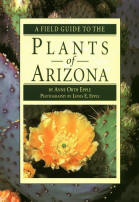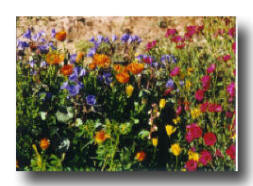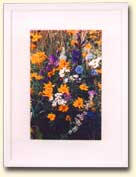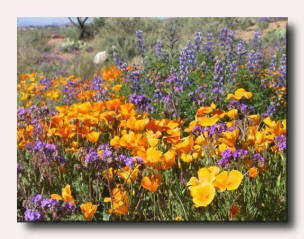

The High Country Xeriscape Council of Arizona is a non-profit 501 (c) (3) corporation dedicated to educating our communities about water-wise gardening. For additional information write:
HCXCA
4397 E AZ Highway 260
Payson, AZ 85541
Wildflower Garden
Have you ever wished you could find something that would grow with little (if any) water, give you lots of interesting color and texture over a long period of time, attract birds and other small animals, and required little (if any) attention? Sounds too good to be true, doesn’t it. Guess what! It is good, and it is true, if you’re willing to do the preparation work, and choose the right seed! How about trying a wildflower meadow mix for your property border, large central bed, driveway edges or controlled hillside?
of interesting color and texture over a long period of time, attract birds and other small animals, and required little (if any) attention? Sounds too good to be true, doesn’t it. Guess what! It is good, and it is true, if you’re willing to do the preparation work, and choose the right seed! How about trying a wildflower meadow mix for your property border, large central bed, driveway edges or controlled hillside?
Our native wildflowers and grasses re-seed themselves in the late summer and fall, as the annuals seed and die back, and new seedlings start to sprout during the late winter. The perennials often die back to the ground in the winter, but the roots carry over, and new plants can be seen breaking ground in early spring. If you want to try planting a native wildflower and/or grass mix, and you don’t want to wait until next fall, NOW is the perfect time to get it planted, and a little attention paid to detail at the beginning will yield optimum results later on.
While searching for the right combination of seeds, get the area prepared. Mow back any existing grasses or weeds that are more than 6 inches high. Rake the area well to break up the surface of the soil. Broadcast the seed at the prescribed amount for what you are planting. Cover seed with 1/4” mix of compost and sand. Mulch immediately with a light layer of mulch. Mulching holds in moisture, adds nutrients, and keeps weeds at bay. Don’t use compacted material, or anything too heavy because the little seedlings will need to get through it.
Now, for the hard part! Seedbeds must be kept damp (which is one of the reasons why you need to plant in the early spring). Give a good sprinkling twice a day for the first three weeks, and once a day for the next three weeks. After the initial 6 weeks, give a good soaking once a week or so for another month, and finally twice a month if needed until frost. Obviously, this schedule is for extremely dry conditions. You have to be the judge, if your plants look healthy, watering times can be delayed stretched out. Once established, your wildflower borders will basically take care of themselves, with just a good mowing and mulching in the late autumn.
The key to success is to choose a combination of flowers and grasses that are hardy, drought resistant, and heat tolerant. Plants of the Southwest has two wildflower mixes that are suitable (plus many individual varieties, of course). The High Plains Pinion-Juniper Mix #P4021 is rated for 4,000 to 8,000 feet in altitude and 15” (+/- 40%) rainfall! This colorful and sturdy mix includes blue flax, Rocky Mountain penstemon, pale evening primrose, poppies, chocolate flower, bachelor buttons, daisies, firewheel, yellow coneflower, Mexican hat, coreopsis, skyrocket, gayfeather and prairie aster. P4005 High Desert Mix will flourish  at elevations from 3,000 feet to 6,000 feet, with hot summers, cold winters and 5-18” of rainfall per year. This combination includes sand verbena, pruple aster, coreopsis, New Mexico lupine, verbena, Mojave bluebells, purple prairie clover, desert marigold, sand penstemon, blue flax, evening primrose, coneflowers and gaillardia. Plants of the Southwest can be contacted by calling 1-800-788-SEED (7333) or www.plantsofthesouthwest.com or if you’d like to send them an e-mail: contact@plantsofthesouthwest.com.
at elevations from 3,000 feet to 6,000 feet, with hot summers, cold winters and 5-18” of rainfall per year. This combination includes sand verbena, pruple aster, coreopsis, New Mexico lupine, verbena, Mojave bluebells, purple prairie clover, desert marigold, sand penstemon, blue flax, evening primrose, coneflowers and gaillardia. Plants of the Southwest can be contacted by calling 1-800-788-SEED (7333) or www.plantsofthesouthwest.com or if you’d like to send them an e-mail: contact@plantsofthesouthwest.com.
copyright 2003© HCXCA